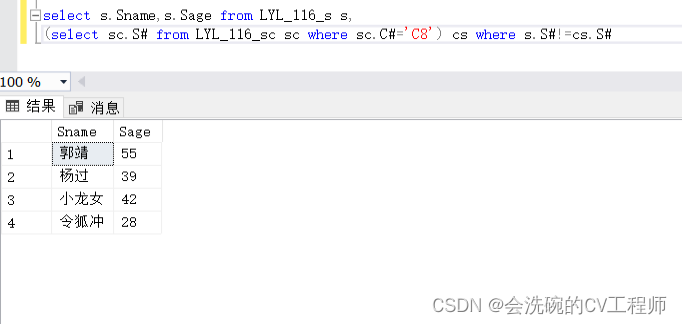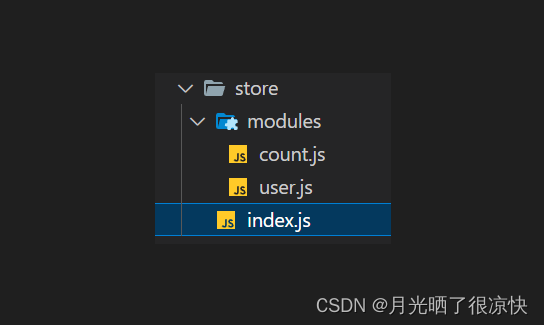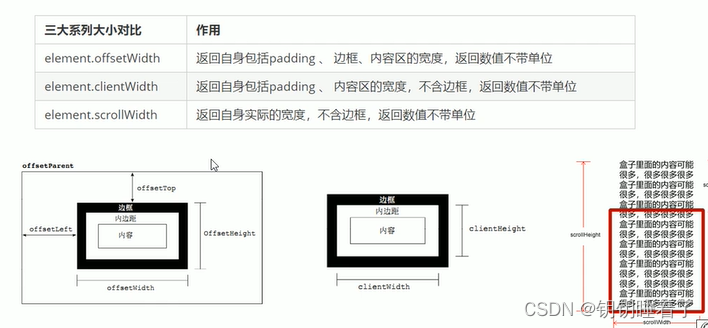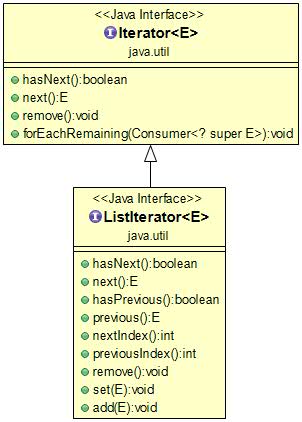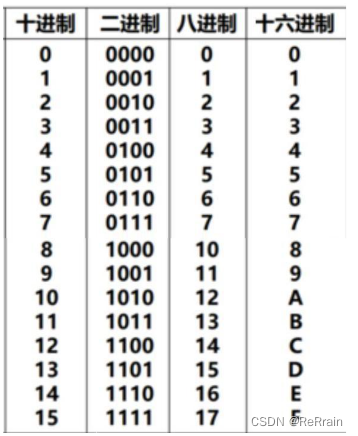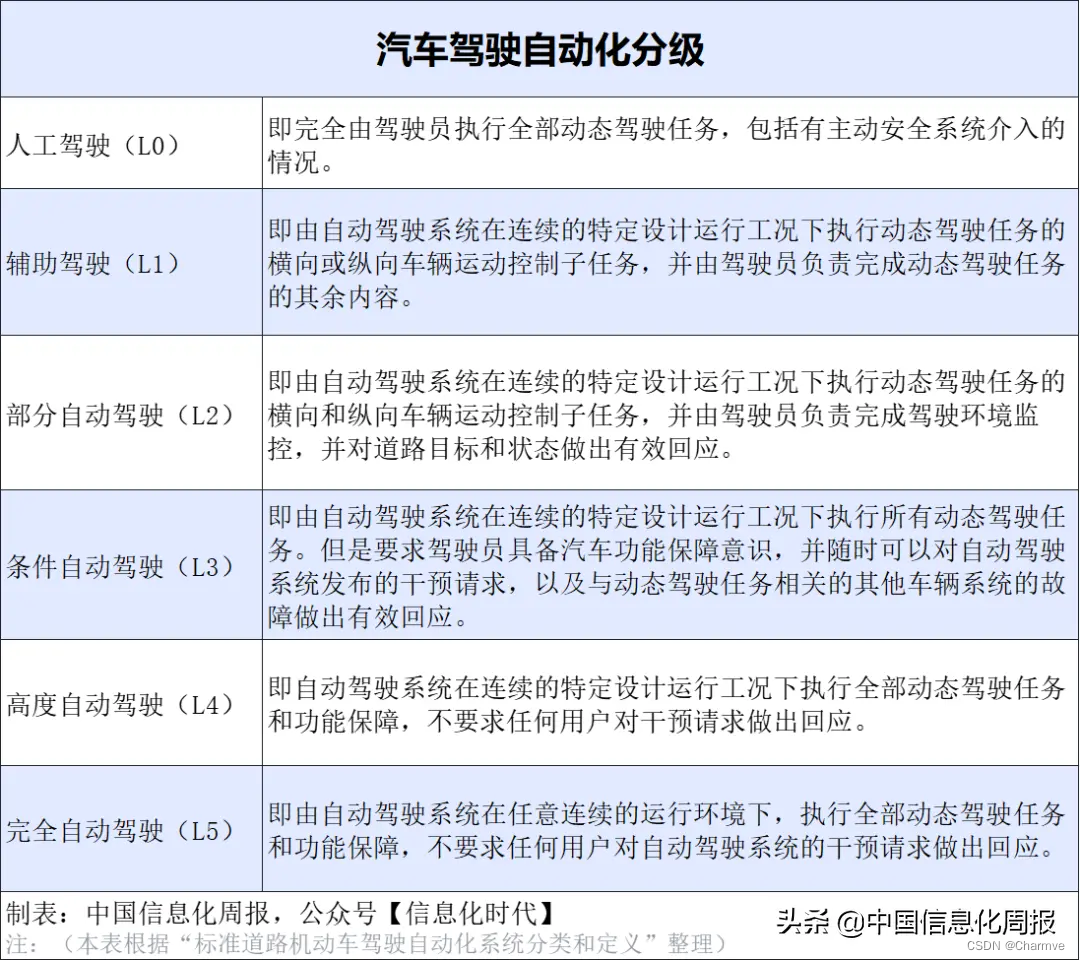目录
前言
一、pandas常用数据类型
综述
1.一维数组(Series)与常用操作
(1) 通过列表创建Series
(2)创建Series时指定索引
(3)Series位置和标签的使用
(4)通过字典创建Series
(5)键值和指定的索引不匹配
(6)不同索引数据的自动对齐
(7)Series索引的修改
2.时间序列与常用操作
(1)创建时间序列
(2)使用日期时间做索引,创建Series对象
(3)period_range生成时间序列
3.二维表格(DataFrame)与常用操作
(1)DataFrame的创建
(2)DataFrame创建时指定列名和索引
(3)DataFrame创建时的空缺值
(4)DataFrame的属性查询
4.索引对象
(1)显示DataFrame的索引和列
(2)对DataFrame的索引和列的测试
二、pandas索引操作
1.重新索引(Series)
2.重新索引时填充缺失值(Series中)
3.缺失值的前后向填充(Series)
4.重新索引(DateFrame中)
5.重新索引, 传入fill_value=n填充缺失值(DateFrame中)
6.reindex函数参数
7.更换索引set_index函数
三、DataFrame的数据查询与编辑
1.DataFrame的数据查询
(1)选取列
(2)选取行
(3)head,tail,sample方法选取行
(4)选取行和列
(5)布尔选择
2.DataFrame的数据的编辑
(1)增加数据
(2)删除数据
(3)修改数据
四、pandas数据运算
1.算数运算
(1)series相加
(2)DataFrame类型的数据相加
2.函数应用和映射
(1)将水果价格表中的“元”去掉
(2)apply函数与applymap函数的使用方法
3.排序
(1)Series的排序
(2)DataFrame的排序
4.汇总与统计
(1)数据汇总
(2)描述与统计分析
前言
- 熟练掌握pandas一维数组series结构的使用
- 熟练掌握pandas时间序列对象的使用
- 熟练掌握pandas二维数组DataFrame结构的创建
- 熟练掌握DataFrame结构中数据的选择与查看
- 熟练掌握查看DataFrame结构中数据特征的方法
- 数量掌握DataFrame结构的排序方法
- 数量掌握DataFrame结构中数据的分组和聚合方法
- 数量掌握DataFrame结构中异常值的查看与处理
- 数量掌握DataFrame结构中缺失值的查看与处理
- 数量掌握DataFrame结构重复值的查看与处理
- 数量掌握DataFrame结构中数据差分的使用
- 熟练掌握pandas提供的透视表与交叉表技术
- 数量掌握DataFrame结构中数据的重采样技术
一、pandas常用数据类型
综述
扩展库pandas是基于扩展库numpy和matplotlib的数据分析模块,是一个开源项目,提供了大量标准数据模型和高校操作大型数据集所需要的功能。可以说pandas是使得python能够称为高效且强大的数据分析行业首选语言的重要因素之一。
扩展库pandas常用的数据结构有:
- Series:带标签的一维数组
- DatetimeIndex:时间序列
- DateFrame:带标签且大小可变的二维表格结构
1.一维数组(Series)与常用操作
Series是pandas提供的一维数组,由索引和值两部分组成,是一个类似于字典的结构。其中值的类型可以不同,如果在创建时没有明确指定索引则会自动使用从0开始的非零整数作为索引。
格式:

(1) 通过列表创建Series
>>> import pandas as pd
>>> obj=pd.Series([1,-2,3,-4]) #仅有一个数组构成
>>> obj
0 1
1 -2
2 3
3 -4
dtype: int64
(2)创建Series时指定索引
尽管创建Series指定了index参数,实际pandas还是有隐藏的index位置信息的。所以Series有两套描述某条数据的手段:位置和标签。
>>> i=["a","c","d","a"]
>>> v=[2,4,5,7]
>>> t=pd.Series(v,index=i,name="col")
>>> print(t)
a 2
c 4
d 5
a 7
Name: col, dtype: int64
>>> t
a 2
c 4
d 5
a 7
Name: col, dtype: int64
(3)Series位置和标签的使用
>>> val=[2,3,5,6]
>>> idex1=range(10,14)
>>> idex2="hello the cruel world".split()
>>> s0=pd.Series(val)
>>> s0 #显示了index位置信息
0 2
1 3
2 5
3 6
dtype: int64
>>> s0.index
RangeIndex(start=0, stop=4, step=1)
>>> s0[0]
2
>>> s1=pd.Series(val,index=idex1)
>>> s1
10 2
11 3
12 5
13 6
dtype: int64
>>> print(s1.index)
RangeIndex(start=10, stop=14, step=1)
>>> t=pd.Series(val,index=idex2)
>>> t #隐藏了index位置信息
hello 2
the 3
cruel 5
world 6
dtype: int64
>>> print(t.index)
Index(['hello', 'the', 'cruel', 'world'], dtype='object')
>>> print(s1[10])
2
>>> print('default:',t[0],'label:',t['hello'])
default: 2 label: 2
(4)通过字典创建Series
>>> sdata={'Ohio':35000,'Texas':71000,'Oregon':16000,'Utah':5000}
>>> obj3=pd.Series(sdata) #字典的键直接成为索引
>>> obj3
Ohio 35000
Texas 71000
Oregon 16000
Utah 5000
dtype: int64
(5)键值和指定的索引不匹配
>>> sdata={"a":100,"b":200,"e":300}
>>> letter=["a","c","e"]
>>> obj=pd.Series(sdata,index=letter)
>>> type(obj)
<class 'pandas.core.series.Series'>
>>> print(obj) #以index为准,不匹配的值为NAN
a 100.0
c NaN
e 300.0
dtype: float64
(6)不同索引数据的自动对齐
>>> sdata={'Ohio':35000,'Texas':71000,'Oregon':16000,'Utah':5000}
>>> obj1=pd.Series(sdata)
>>> obj1
Ohio 35000
Texas 71000
Oregon 16000
Utah 5000
dtype: int64
>>> states=['Calofornia','Ohio','Oregon','Texas']
>>> obj2=pd.Series(sdata,index=states)
>>> obj2
Calofornia NaN
Ohio 35000.0
Oregon 16000.0
Texas 71000.0
dtype: float64
>>> obj1+obj2 #按相同索引自动加,只一个索引值为NAN
Calofornia NaN
Ohio 70000.0
Oregon 32000.0
Texas 142000.0
Utah NaN
dtype: float64
(7)Series索引的修改
>>> obj=pd.Series([4,7,-3,2])
>>> obj
0 4
1 7
2 -3
3 2
dtype: int64
>>> obj.index=['张三','李四','王五','赵六']
>>> obj
张三 4
李四 7
王五 -3
赵六 2
dtype: int64
2.时间序列与常用操作
(1)创建时间序列
时间序列对象一般使用pandas的date_range()函数生成,可以指定日期时间的起始和结束范围、时间间隔以及数据数量等参数,语法为:

其中参数start和end分别用来指定起止日期时间;参数periods用来指定要生成的数据数量;参数freq用来指定时间间隔,默认为'D',表示相邻两个日期之间相差一天,更多取值和含义见:
http://pandas.pydata.org/pandasdocs/stable/user_guide/timeseries.html#timeseries-offset-aliases
另外,pandas的Timestamp类也支持很多日期时间有关的操作。
- start表示起始日期,end指定结束日期,periods指定生产的数据数量
- freq指定间隔,D表示天,W表示周,H表示小时
- M表示月末最后一天,MS表示月初第一天
- T表示分钟,Y表示年末最后一天,YS表示年初第一天
>>> import pandas as pd
>>> print(pd.date_range(start='20190601',end='20190630',freq='5D')) #间隔五天
DatetimeIndex(['2019-06-01', '2019-06-06', '2019-06-11', '2019-06-16',
'2019-06-21', '2019-06-26'],
dtype='datetime64[ns]', freq='5D')
>>> print(pd.date_range(start='20190601',end='20190630',freq='W')) #间隔一周
DatetimeIndex(['2019-06-02', '2019-06-09', '2019-06-16', '2019-06-23',
'2019-06-30'],
dtype='datetime64[ns]', freq='W-SUN')
>>> print(pd.date_range(start='20190601',periods=5,freq='2D')) #间隔两天
DatetimeIndex(['2019-06-01', '2019-06-03', '2019-06-05', '2019-06-07',
'2019-06-09'],
dtype='datetime64[ns]', freq='2D')
>>> print(pd.date_range(start='20190601',periods=8,freq='2H')) #2小时,8个数据
DatetimeIndex(['2019-06-01 00:00:00', '2019-06-01 02:00:00',
'2019-06-01 04:00:00', '2019-06-01 06:00:00',
'2019-06-01 08:00:00', '2019-06-01 10:00:00',
'2019-06-01 12:00:00', '2019-06-01 14:00:00'],
dtype='datetime64[ns]', freq='2H')
>>> print(pd.date_range(start='201906010300',periods=12,freq='T')) #间隔一分钟
DatetimeIndex(['2019-06-01 03:00:00', '2019-06-01 03:01:00',
'2019-06-01 03:02:00', '2019-06-01 03:03:00',
'2019-06-01 03:04:00', '2019-06-01 03:05:00',
'2019-06-01 03:06:00', '2019-06-01 03:07:00',
'2019-06-01 03:08:00', '2019-06-01 03:09:00',
'2019-06-01 03:10:00', '2019-06-01 03:11:00'],
dtype='datetime64[ns]', freq='T')
>>> pd.date_range(start='20190101',end='20191231',freq='M') #一月,月末最后一天
DatetimeIndex(['2019-01-31', '2019-02-28', '2019-03-31', '2019-04-30',
'2019-05-31', '2019-06-30', '2019-07-31', '2019-08-31',
'2019-09-30', '2019-10-31', '2019-11-30', '2019-12-31'],
dtype='datetime64[ns]', freq='M')
>>> pd.date_range(start='20190101',periods=6,freq='A') #间隔一年,年末最后一天
DatetimeIndex(['2019-12-31', '2020-12-31', '2021-12-31', '2022-12-31',
'2023-12-31', '2024-12-31'],
dtype='datetime64[ns]', freq='A-DEC')
>>> pd.date_range(start='20190101',periods=6,freq='AS') #间隔一年,年初第一天
DatetimeIndex(['2019-01-01', '2020-01-01', '2021-01-01', '2022-01-01',
'2023-01-01', '2024-01-01'],
dtype='datetime64[ns]', freq='AS-JAN')
(2)使用日期时间做索引,创建Series对象
>>>data=pd.Series(index=pd.date_range(start='20190701',periods=24,freq='H'),data=range(24))
>>> print(data[:5]) #前5条数据
2019-07-01 00:00:00 0
2019-07-01 01:00:00 1
2019-07-01 02:00:00 2
2019-07-01 03:00:00 3
2019-07-01 04:00:00 4
Freq: H, dtype: int64
>>> print(data.resample('3H').mean()) #3分钟重采样,计算均值
2019-07-01 00:00:00 1.0
2019-07-01 03:00:00 4.0
2019-07-01 06:00:00 7.0
2019-07-01 09:00:00 10.0
2019-07-01 12:00:00 13.0
2019-07-01 15:00:00 16.0
2019-07-01 18:00:00 19.0
2019-07-01 21:00:00 22.0
Freq: 3H, dtype: float64
>>> print(data.resample('5H').sum()) #5小时重采样,求和
2019-07-01 00:00:00 10
2019-07-01 05:00:00 35
2019-07-01 10:00:00 60
2019-07-01 15:00:00 85
2019-07-01 20:00:00 86
Freq: 5H, dtype: int64
>>> data.resample('5H').ohlc() #5小时重采样,统计O(OPEN)H(HIGH)L(LOW)C(CLOSE)值
open high low close
2019-07-01 00:00:00 0 4 0 4
2019-07-01 05:00:00 5 9 5 9
2019-07-01 10:00:00 10 14 10 14
2019-07-01 15:00:00 15 19 15 19
2019-07-01 20:00:00 20 23 20 23
>>> data.index=data.index+pd.Timedelta('1D') #所有日期替换为第二天
>>> data[:5]
2019-07-02 00:00:00 0
2019-07-02 01:00:00 1
2019-07-02 02:00:00 2
2019-07-02 03:00:00 3
2019-07-02 04:00:00 4
Freq: H, dtype: int64
>>> print(pd.Timestamp('201909300800').is_leap_year) #查看指定日期时间所在年是否闰年
False
>>> day=pd.Timestamp('20191025') #查看指定日期所在的季度和月份
>>> print(day.quarter,day.month)
4 10
>>> print(day.to_pydatetime()) #转换为python的日期时间对象
2019-10-25 00:00:00(3)period_range生成时间序列
>>> pd.period_range('20200601','20200630',freq='W')
PeriodIndex(['2020-06-01/2020-06-07', '2020-06-08/2020-06-14',
'2020-06-15/2020-06-21', '2020-06-22/2020-06-28',
'2020-06-29/2020-07-05'],
dtype='period[W-SUN]')
>>> pd.period_range('20200601','20200610',freq='D')
PeriodIndex(['2020-06-01', '2020-06-02', '2020-06-03', '2020-06-04',
'2020-06-05', '2020-06-06', '2020-06-07', '2020-06-08',
'2020-06-09', '2020-06-10'],
dtype='period[D]')
>>> pd.period_range('20200601','20200630',freq='H')
PeriodIndex(['2020-06-01 00:00', '2020-06-01 01:00', '2020-06-01 02:00',
'2020-06-01 03:00', '2020-06-01 04:00', '2020-06-01 05:00',
'2020-06-01 06:00', '2020-06-01 07:00', '2020-06-01 08:00',
'2020-06-01 09:00',
...
'2020-06-29 15:00', '2020-06-29 16:00', '2020-06-29 17:00',
'2020-06-29 18:00', '2020-06-29 19:00', '2020-06-29 20:00',
'2020-06-29 21:00', '2020-06-29 22:00', '2020-06-29 23:00',
'2020-06-30 00:00'],
dtype='period[H]', length=697)
3.二维表格(DataFrame)与常用操作
DataFrame是一个表格型的数据结构,它含有一组有序的列,每列可以是不同的值(数值、字符串、布尔值等)。
DataFrame既有行索引也有列索引,它可以被看做由Series组成的字典(共用同一个索引)。
格式:
pd.DataFrame(data=None,index=None,colunms=None,dtype=None,copy=Flase)
(1)DataFrame的创建
>>> data={
... 'name':['张三','李四','王五','小明'],
... 'sex':['female','female','male','male'],
... 'year':[2001,2001,2003,2002],
... 'city':['北京','上海','广州','北京']
... }
>>> df=pd.DataFrame(data)
>>> df
name sex year city
0 张三 female 2001 北京
1 李四 female 2001 上海
2 王五 male 2003 广州
3 小明 male 2002 北京
>>> type(df)
<class 'pandas.core.frame.DataFrame'>
(2)DataFrame创建时指定列名和索引
DateFrame构造函数的columns函数给出列的名字,index给出label标签。
>>> df1=pd.DataFrame(data,columns=['name','year','sex','city'])
>>> print(df1)
name year sex city
0 张三 2001 female 北京
1 李四 2001 female 上海
2 王五 2003 male 广州
3 小明 2002 male 北京
>>> df3=pd.DataFrame(data,columns=['name','sex','year','city'],index=['a','b','c','d'])
>>> print(df3)
name sex year city
a 张三 female 2001 北京
b 李四 female 2001 上海
c 王五 male 2003 广州
d 小明 male 2002 北京
(3)DataFrame创建时的空缺值
和Series一样,如果传入的列在数据中找不到,就会产生NA值。
>>> df2=pd.DataFrame(data,columns=['name','year','sex','city','address'])
>>> print(df2)
name year sex city address
0 张三 2001 female 北京 NaN
1 李四 2001 female 上海 NaN
2 王五 2003 male 广州 NaN
3 小明 2002 male 北京 NaN
(4)DataFrame的属性查询
| 函数 | 返回值 |
| values | 元素 |
| index | 索引 |
| columns | 列名 |
| dtypes | 类型 |
| size | 元素个数 |
| ndim | 维度数 |
| shape | 数据形状(行列数目) |
>>> print(df.values)
[['张三' 'female' 2001 '北京']
['李四' 'female' 2001 '上海']
['王五' 'male' 2003 '广州']
['小明' 'male' 2002 '北京']]
>>> print(df.columns)
Index(['name', 'sex', 'year', 'city'], dtype='object')
>>> print(df.size)
16
>>> print(df.ndim)
2
>>> print(df.shape)
(4, 4)
4.索引对象
pandas的索引对象负责管理轴标签和其他元数据(比如轴名称等)。
构建Series或DataFrame时,所用到的任何数组或其他序列的标签都会被转换成一个Index。
DataFrame行列,axis图解:

(1)显示DataFrame的索引和列
>>> df=pd.DataFrame(data,columns=['name','sex','year','city'],index=['a','b','c','d'])
>>> df
name sex year city
a 张三 female 2001 北京
b 李四 female 2001 上海
c 王五 male 2003 广州
d 小明 male 2002 北京
>>> df.index
Index(['a', 'b', 'c', 'd'], dtype='object')
>>> print(df.columns)
Index(['name', 'sex', 'year', 'city'], dtype='object')
(2)对DataFrame的索引和列的测试
每个索引都有一些方法和属性,它们可用于设置逻辑并回答有关该索引所包含的数据的常见问题。Index的常用方法和属性见下表。
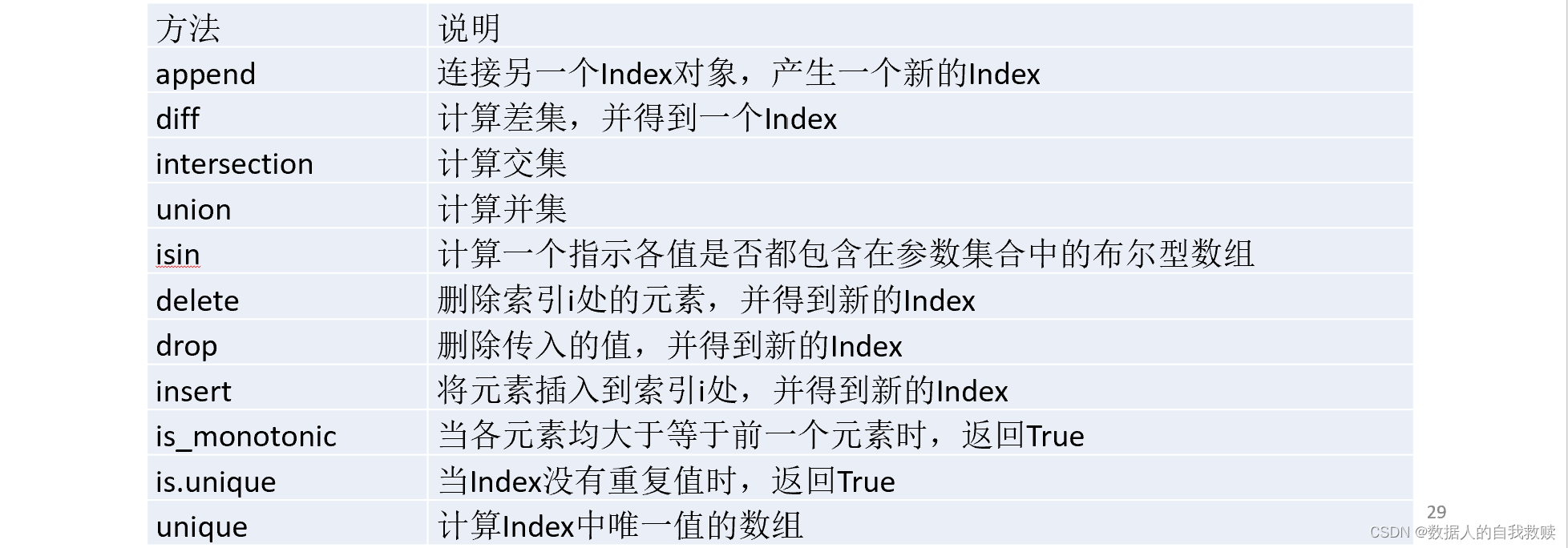
>>> df.index
Index(['a', 'b', 'c', 'd'], dtype='object')
>>> print(df.columns)
Index(['name', 'sex', 'year', 'city'], dtype='object')
>>> print('name' in df.columns)
True
>>> print('a' in df.index)
True
二、pandas索引操作
1.重新索引(Series)
索引对象是无法修改的,因此重新索引是指对索引重新排序而不是重新命名,如果某个索引值不存在的话,会引入缺失值。
对于重建索引引入的缺失值,可以利用fill_value参数填充。
>>> obj=pd.Series([7.2,-4.3,4.5,3.6],index=['b','a','d','c'])
>>> obj
b 7.2
a -4.3
d 4.5
c 3.6
dtype: float64
>>> obj.reindex(['a','b','c','d','e'])
a -4.3
b 7.2
c 3.6
d 4.5
e NaN
dtype: float64
2.重新索引时填充缺失值(Series中)
对于顺序数据,比如时间序列,重新索引时可能需要进行插值或填值处理,利用参数method选项可以设置:
method='ffill'或'pad':表示前向值填充
method='bfill'或'backfill',表示后向值填充
>>> obj=pd.Series([7.2,-4.3,4.5,3.6],index=['b','a','d','c'])
>>> obj.reindex(['a','b','c','d','e'],fill_value=0)
a -4.3
b 7.2
c 3.6
d 4.5
e 0.0
dtype: float64
3.缺失值的前后向填充(Series)
>>> import numpy as np
>>> obj=pd.Series(['blue','red','black'],index=[0,2,4])
>>> obj
0 blue
2 red
4 black
dtype: object
>>> obj.reindex(np.arange(6),method='ffill')
0 blue
1 blue
2 red
3 red
4 black
5 black
dtype: object
>>> obj.reindex(np.arange(6),method='backfill')
0 blue
1 red
2 red
3 black
4 black
5 NaN
dtype: object
4.重新索引(DateFrame中)
>>> import numpy as np
>>> import pandas as pd
>>> df4=pd.DataFrame(np.arange(9).reshape(3,3),index=['a','c','d'],columns=['one','two','four'])
>>> df4
one two four
a 0 1 2
c 3 4 5
d 6 7 8
>>> df4.reindex(index=['a','b','c','d'],columns=['one','two','three','four'])
one two three four
a 0.0 1.0 NaN 2.0
b NaN NaN NaN NaN
c 3.0 4.0 NaN 5.0
d 6.0 7.0 NaN 8.0
5.重新索引, 传入fill_value=n填充缺失值(DateFrame中)
>>> df4.reindex(index=['a','b','c','d'],columns=['one','two','three','four'],fill_value=100)
one two three four
a 0 1 100 2
b 100 100 100 100
c 3 4 100 5
d 6 7 100 8
6.reindex函数参数

7.更换索引set_index函数
如果不希望使用默认的行索引,则可以在创建的时候通过index函数来设置。
在DateFrame数据中,如果希望将列数据作为索引,则可以通过set_index方法来实现。
>>> data={
... 'name':['张三','李四','王五','小明'],
... 'sex':['female','female','male','male'],
... 'year':[2001,2001,2003,2002],
... 'city':['北京','上海','广州','北京']
... }
>>> df1=pd.DataFrame(data,columns=['name','year','sex','city'])
>>> df1
name year sex city
0 张三 2001 female 北京
1 李四 2001 female 上海
2 王五 2003 male 广州
3 小明 2002 male 北京
>>> df5=df1.set_index('city')
>>> df5
name year sex
city
北京 张三 2001 female
上海 李四 2001 female
广州 王五 2003 male
北京 小明 2002 male
三、DataFrame的数据查询与编辑
1.DataFrame的数据查询
在数据分析中,选取需要的数据进行分析处理是最基本的操作。在pandas中需要通过索引完成数据的选取。
(1)选取列
通过列索引或以属性的方式可以单独获取DataFrame的列数据,返回的数据类型为Series。
>>> df5
name year sex
city
北京 张三 2001 female
上海 李四 2001 female
广州 王五 2003 male
北京 小明 2002 male
>>> w1=df5['name']
>>> print("选取1列数据:\n",w1)
选取1列数据:
city
北京 张三
上海 李四
广州 王五
北京 小明
Name: name, dtype: object
>>> w2=df5[['name','year']]
>>> w2
name year
city
北京 张三 2001
上海 李四 2001
广州 王五 2003
北京 小明 2002
(2)选取行
通过切片形式可以选取一行或多行数据。
>>> print(df4)
one two four
a 0 1 2
c 3 4 5
d 6 7 8
>>> print("显示前2行:\n",df4[:2])
显示前2行:
one two four
a 0 1 2
c 3 4 5
>>> print("显示前2-3行:\n",df4[1:3])
显示前2-3行:
one two four
c 3 4 5
d 6 7 8
(3)head,tail,sample方法选取行
选取通过DataFrame提供的head和tail方法可以得到多行数据,但是用这两种方法得到的数据都是从开始或者末尾获取连续的数据,而利用sample可以随机抽取数据并显示。

>>> df=pd.DataFrame(np.arange(100).reshape(20,5))
>>> df.head() #前5行
0 1 2 3 4
0 0 1 2 3 4
1 5 6 7 8 9
2 10 11 12 13 14
3 15 16 17 18 19
4 20 21 22 23 24
>>> df.head(3) #前3行
0 1 2 3 4
0 0 1 2 3 4
1 5 6 7 8 9
2 10 11 12 13 14
>>> df.tail() #选尾5行
0 1 2 3 4
15 75 76 77 78 79
16 80 81 82 83 84
17 85 86 87 88 89
18 90 91 92 93 94
19 95 96 97 98 99
>>> df.tail(3) #选尾三行
0 1 2 3 4
17 85 86 87 88 89
18 90 91 92 93 94
19 95 96 97 98 99
>>> df.sample(3) #随机选3
0 1 2 3 4
7 35 36 37 38 39
3 15 16 17 18 19
1 5 6 7 8 9
>>> df.nlargest(3,3) #返回指定列最大的前三行
0 1 2 3 4
19 95 96 97 98 99
18 90 91 92 93 94
17 85 86 87 88 89
(4)选取行和列

>>> print(df5.loc[:,['name','year']]) #显示name和year两列
name year
city
北京 张三 2001
上海 李四 2001
广州 王五 2003
北京 小明 2002
>>> print(df5.loc[['北京','上海'],['name','year']]) #显示北京和上海中的name和year两列
name year
city
北京 张三 2001
北京 小明 2002
上海 李四 2001
>>> print(df5.iloc[:2]) #用iloc选行与列,显示前两列
name year sex
city
北京 张三 2001 female
上海 李四 2001 female
>>> print(df5.iloc[[1,3]]) #显示1、3行
name year sex
city
上海 李四 2001 female
北京 小明 2002 male
>>> print(df5.iloc[[1,3],[1,2]]) #显示第一行1、2列元素和第三行1、2列元素
year sex
city
上海 2001 female
北京 2002 male
(5)布尔选择
可以对DateFrame中的数据进行布尔方式选择
>>> df5[df5['year']==2001]
name year sex
city
北京 张三 2001 female
上海 李四 2001 female
2.DataFrame的数据的编辑
(1)增加数据
增加一行直接通过append方法传入字典结构数据即可。
>>> import pandas as pd
>>> data={
... 'name':['张三','李四','王五','小明'],
... 'sex':['female','female','male','male'],
... 'year':[2001,2001,2003,2002],
... 'city':['北京','上海','广州','北京']
... }
>>> df=pd.DataFrame(data)
>>> data1={'city':'兰州','name':'李红','year':2005,'sex':'female'}
>>> df.append(data1,ignore_index=True)
Warning (from warnings module):
File "<pyshell#43>", line 1
FutureWarning: The frame.append method is deprecated and will be removed from pandas in a future version. Use pandas.concat instead.
name sex year city
0 张三 female 2001 北京
1 李四 female 2001 上海
2 王五 male 2003 广州
3 小明 male 2002 北京
4 李红 female 2005 兰州
增加列时,只需为要增加的列赋值即可创建一个新的列。
>>> df5['age']=20
>>> df5['C']=[85,78,96,80]
>>> df5
name year sex age C
city
北京 张三 2001 female 20 85
上海 李四 2001 female 20 78
广州 王五 2003 male 20 96
北京 小明 2002 male 20 80
(2)删除数据
删除数据直接用drop方法,通过axis参数确定删除的是行/列。默认数据删除不修改原数据,需要在原数据删除行列时需要设置参数inplace=True。
>>>#删除数据行
>>> print(df5.drop('广州'))
name year sex age C
city
北京 张三 2001 female 20 85
上海 李四 2001 female 20 78
北京 小明 2002 male 20 80
>>>#删除数据列
>>> print(df5.drop('age',axis=1,inplace=True))
None
>>>
>>> df5
name year sex C
city
北京 张三 2001 female 85
上海 李四 2001 female 78
广州 王五 2003 male 96
北京 小明 2002 male 80
(3)修改数据
修改数据时直接对选择的数据赋值即可。
需要注意的是,数据修改是直接对DataFrame数据修改,操作无法撤销,因此更改数据时要做好数据备份。
data
{'name': ['张三', '李四', '王五', '小明'], 'sex': ['female', 'female', 'male', 'male'], 'year': [2001, 2001, 2003, 2002], 'city': ['北京', '上海', '广州', '北京']}
df=pd.DataFrame(data)
df
name sex year city
0 张三 female 2001 北京
1 李四 female 2001 上海
2 王五 male 2003 广州
3 小明 male 2002 北京
>>> df.iat[0,2]=2020 #修改指定行、列位置的数据值
>>> df.loc[:,'sex']=['male','female','male','female'] #修改某列的值
>>> df.loc[df['sex']=='female','year']=2050 #修改特定行的指定列
>>> df
name sex year city
0 张三 male 2020 北京
1 李四 female 2050 上海
2 王五 male 2003 广州
3 小明 female 2050 北京
>>> df.replace('北京','武汉') #把北京改成武汉
name sex year city
0 张三 male 2020 武汉
1 李四 female 2050 上海
2 王五 male 2003 广州
3 小明 female 2050 武汉
>>> df #原数据不变
name sex year city
0 张三 male 2020 北京
1 李四 female 2050 上海
2 王五 male 2003 广州
3 小明 female 2050 北京
>>> df.replace(['张三','李四'],['赵六','赵八'])
name sex year city
0 赵六 male 2020 北京
1 赵八 female 2050 上海
2 王五 male 2003 广州
3 小明 female 2050 北京
>>> df.replace({'王五':'赵七','小明':'赵九'}) #使用字典指定替换关系
name sex year city
0 张三 male 2020 北京
1 李四 female 2050 上海
2 赵七 male 2003 广州
3 赵九 female 2050 北京
>>> df #原数据不变
name sex year city
0 张三 male 2020 北京
1 李四 female 2050 上海
2 王五 male 2003 广州
3 小明 female 2050 北京
四、pandas数据运算
1.算数运算
pandas的数据对象在进行算术运算时,如果有相同索引则进行算术运算,如果没有,则会自动进行数据对其,但会引入缺失值。
(1)series相加
>>> obj1=pd.Series([5.1,-2.6,7.8,10],index=['a','c','g','f'])
>>> obj1
a 5.1
c -2.6
g 7.8
f 10.0
dtype: float64
>>> obj2=pd.Series([5.1,-2.6,7.8,10],index=['a','c','g','f'])
>>> obj2
a 5.1
c -2.6
g 7.8
f 10.0
dtype: float64
>>> obj1+obj2
a 10.2
c -5.2
g 15.6
f 20.0
dtype: float64
(2)DataFrame类型的数据相加
>>> a=np.arange(6).reshape(2,3)
>>> b=np.arange(4).reshape(2,2)
>>> a
array([[0, 1, 2],
[3, 4, 5]])
>>> b
array([[0, 1],
[2, 3]])
>>> df1=pd.DataFrame(a,columns=['a','b','e'],index=['A','C'])
>>> df1
a b e
A 0 1 2
C 3 4 5
>>> df2=pd.DataFrame(b,columns=['a','b'],index=['A','D'])
>>> df2
a b
A 0 1
D 2 3
>>> df1+df2
a b e
A 0.0 2.0 NaN
C NaN NaN NaN
D NaN NaN NaN
2.函数应用和映射
已定义好的函数可以通过以下三种方法应用到数据:
- map函数:将函数套用到Series的每个元素中
- apply函数:将函数套用到DataFrame的行/列上,行与列通过axis参数设置
- applymap函数,将函数套用到DataFrame的每个元素上
(1)将水果价格表中的“元”去掉
>>> data={'fruit':['apple','grape','banana'],'price':['30元','43元','28元']}
>>> df1=pd.DataFrame(data)
>>> df1
fruit price
0 apple 30元
1 grape 43元
2 banana 28元
>>> def f(x):
... return x.split('元')[0]
...
>>> '30元'.split('元')
['30', '']
>>> df1['price']=df1['price'].map(f)
>>> print('修改后的数据表:\n',df1)
修改后的数据表:
fruit price
0 apple 30
1 grape 43
2 banana 28
(2)apply函数与applymap函数的使用方法
>>> df2=pd.DataFrame(np.random.randn(3,3),columns=['a','b','c'],index=['app','win','mac'])
>>> df2
a b c
app -1.060500 -0.712209 0.779156
win 0.379755 -0.381884 0.695724
mac 0.606400 0.326212 -0.146500
>>> df2.apply(np.mean)
a -0.024781
b -0.255960
c 0.442793
dtype: float64
>>> df2
a b c
app -1.060500 -0.712209 0.779156
win 0.379755 -0.381884 0.695724
mac 0.606400 0.326212 -0.146500
>>> df2.applymap(lambda x:'%.2f'%x)
a b c
app -1.06 -0.71 0.78
win 0.38 -0.38 0.70
mac 0.61 0.33 -0.15
3.排序
sort_index方法:对索引进行排序,默认为升序,降序排序时加参数ascending=False。
sort_values方法:对数值进行排序。by参数设置待排序的列名。
(1)Series的排序
>>> wy=pd.Series([1,-2,4,-4],index=['c','b','a','d'])
>>> wy
c 1
b -2
a 4
d -4
dtype: int64
>>> print('排序后的wy:\n',wy.sort_index())
排序后的wy:
a 4
b -2
c 1
d -4
dtype: int64
>>> print('值排序后的wy:\n',wy.sort_values())
值排序后的wy:
d -4
b -2
c 1
a 4
dtype: int64
(2)DataFrame的排序
对于DataFrame数据排序,通过指定轴方向,使用sort_index函数对行/列索引进行排序。如果要进行列排序,则通过sort_values函数把列名传给by参数即可。
>>> df=pd.DataFrame({'A':np.random.randint(1,100,4),
... 'B':pd.date_range(start='20130101',periods=4,freq='D'),
... 'C':pd.Series([1,2,3,4],index=['zhang','li','zhou','wang'],dtype='float32'),
... 'D':np.array([3]*4,dtype='int32'),
... 'E':pd.Categorical(["test","train","test","train"]),
... 'F':'foo'})
>>> df
A B C D E F
zhang 5 2013-01-01 1.0 3 test foo
li 87 2013-01-02 2.0 3 train foo
zhou 15 2013-01-03 3.0 3 test foo
wang 65 2013-01-04 4.0 3 train foo
>>> df.sort_index(axis=0,ascending=False) #对轴进行排序
A B C D E F
zhou 15 2013-01-03 3.0 3 test foo
zhang 5 2013-01-01 1.0 3 test foo
wang 65 2013-01-04 4.0 3 train foo
li 87 2013-01-02 2.0 3 train foo
>>> df.sort_index(axis=0,ascending=True)
A B C D E F
li 87 2013-01-02 2.0 3 train foo
wang 65 2013-01-04 4.0 3 train foo
zhang 5 2013-01-01 1.0 3 test foo
zhou 15 2013-01-03 3.0 3 test foo
>>> df.sort_index(axis=1,ascending=False)
F E D C B A
zhang foo test 3 1.0 2013-01-01 5
li foo train 3 2.0 2013-01-02 87
zhou foo test 3 3.0 2013-01-03 15
wang foo train 3 4.0 2013-01-04 65
>>> df.sort_values(by='A') #对数据进行排序
A B C D E F
zhang 5 2013-01-01 1.0 3 test foo
zhou 15 2013-01-03 3.0 3 test foo
wang 65 2013-01-04 4.0 3 train foo
li 87 2013-01-02 2.0 3 train foo
>>> df
A B C D E F
zhang 5 2013-01-01 1.0 3 test foo
li 87 2013-01-02 2.0 3 train foo
zhou 15 2013-01-03 3.0 3 test foo
wang 65 2013-01-04 4.0 3 train foo
>>> dff=pd.DataFrame({'A':[3,8,3,9,3,10],'B':[4,1,8,2,6,3]})
>>> dff.sort_values(by=['A','B'],ascending=[True,False]) #A升序B降序
A B
2 3 8
4 3 6
0 3 4
1 8 1
3 9 2
5 10 3
4.汇总与统计
(1)数据汇总
在DataFrame中,可以通过sum方法对每列进行求和汇总,与Excel中的sum函数类似。如果设置axis=1指定轴方向,可以实现按行汇总。
- DataFrame中的汇总
>>> df2
a b c
app -1.060500 -0.712209 0.779156
win 0.379755 -0.381884 0.695724
mac 0.606400 0.326212 -0.146500
>>> print('按列汇总:\n',df2.sum())
按列汇总:
a -0.074344
b -0.767881
c 1.328379
dtype: float64
>>> print('按行汇总:\n',df2.sum(axis=1))
按行汇总:
app -0.993553
win 0.693595
mac 0.786112
dtype: float64
(2)描述与统计分析
利用describe方法对每个数值型的列数据进行统计。
>>> df2
a b c
app -1.060500 -0.712209 0.779156
win 0.379755 -0.381884 0.695724
mac 0.606400 0.326212 -0.146500
>>> df2.describe()
a b c
count 3.000000 3.000000 3.000000
mean -0.024781 -0.255960 0.442793
std 0.904089 0.530539 0.512045
min -1.060500 -0.712209 -0.146500
25% -0.340372 -0.547047 0.274612
50% 0.379755 -0.381884 0.695724
75% 0.493078 -0.027836 0.737440
max 0.606400 0.326212 0.779156
pandas中常用的描述性统计量。

对于类别型特征的描述性统计,可以使用频数统计表。pandas库中通过unique方法获取不重复的数组,利用value_conuts方法实现频数统计。
>>> obj=pd.Series(['a','b','c','a','d','c'])
>>> obj.unique()
array(['a', 'b', 'c', 'd'], dtype=object)
>>> print(obj.unique())
['a' 'b' 'c' 'd']
>>> obj.value_counts()
a 2
c 2
b 1
d 1
dtype: int64



